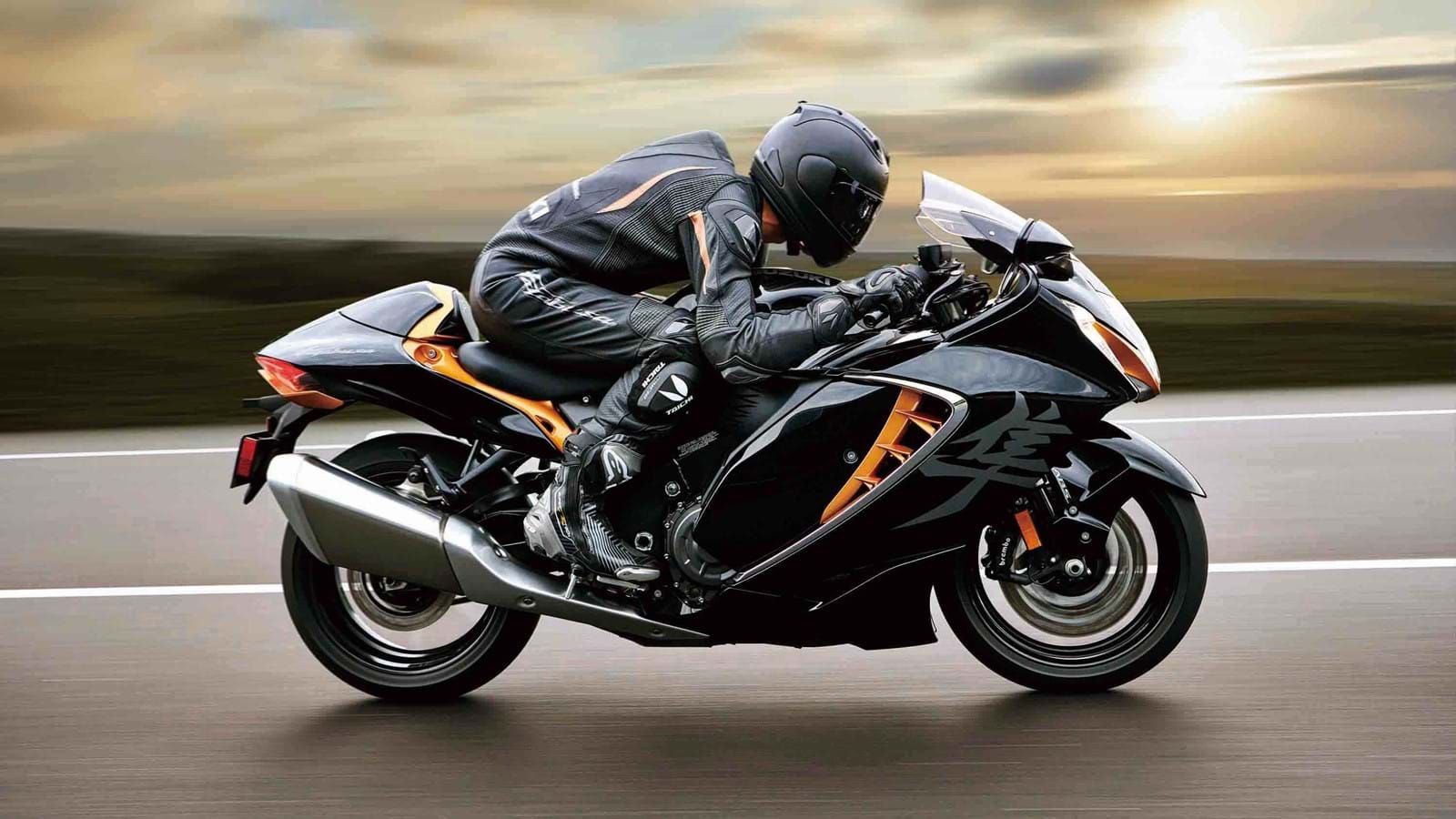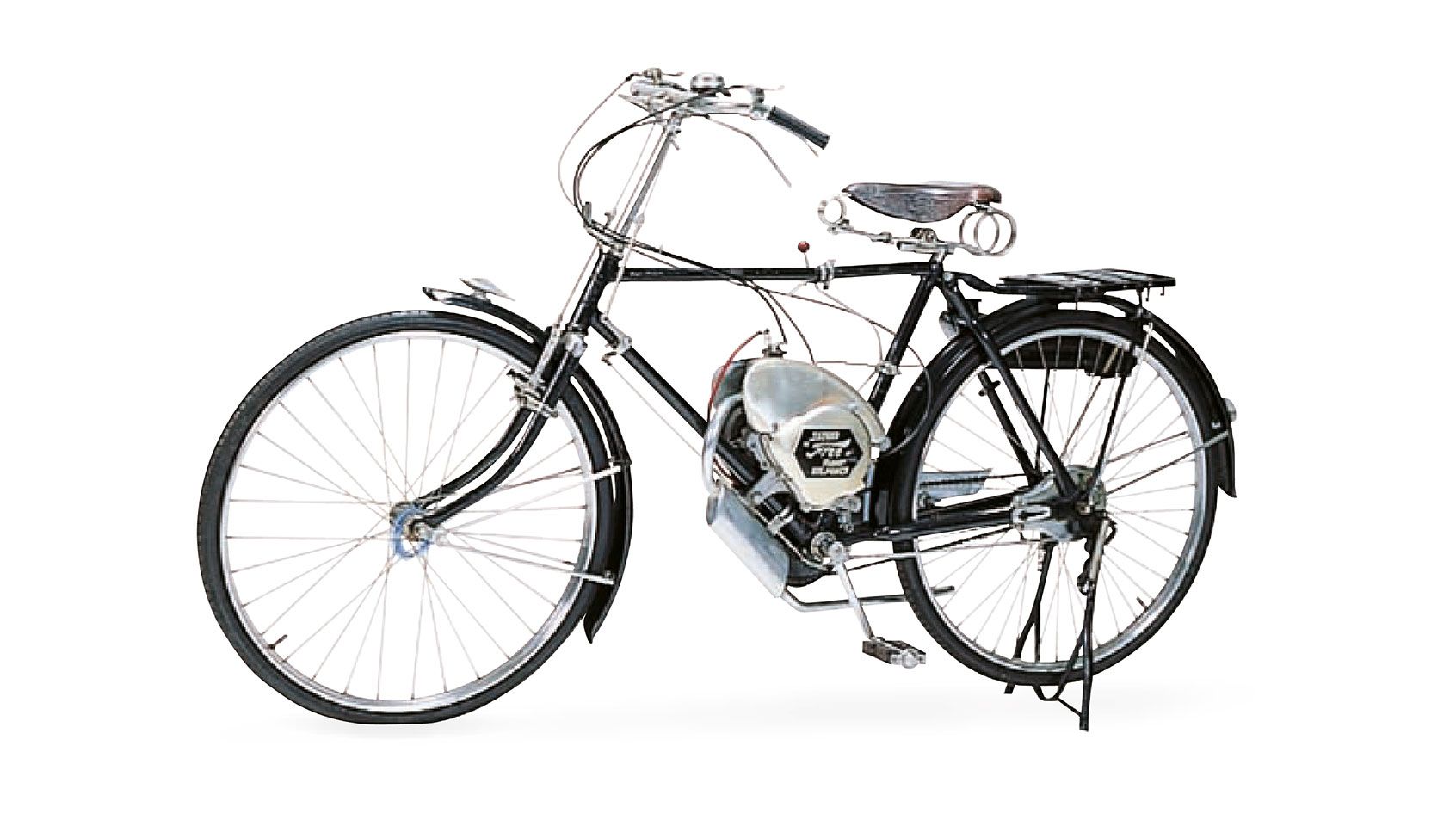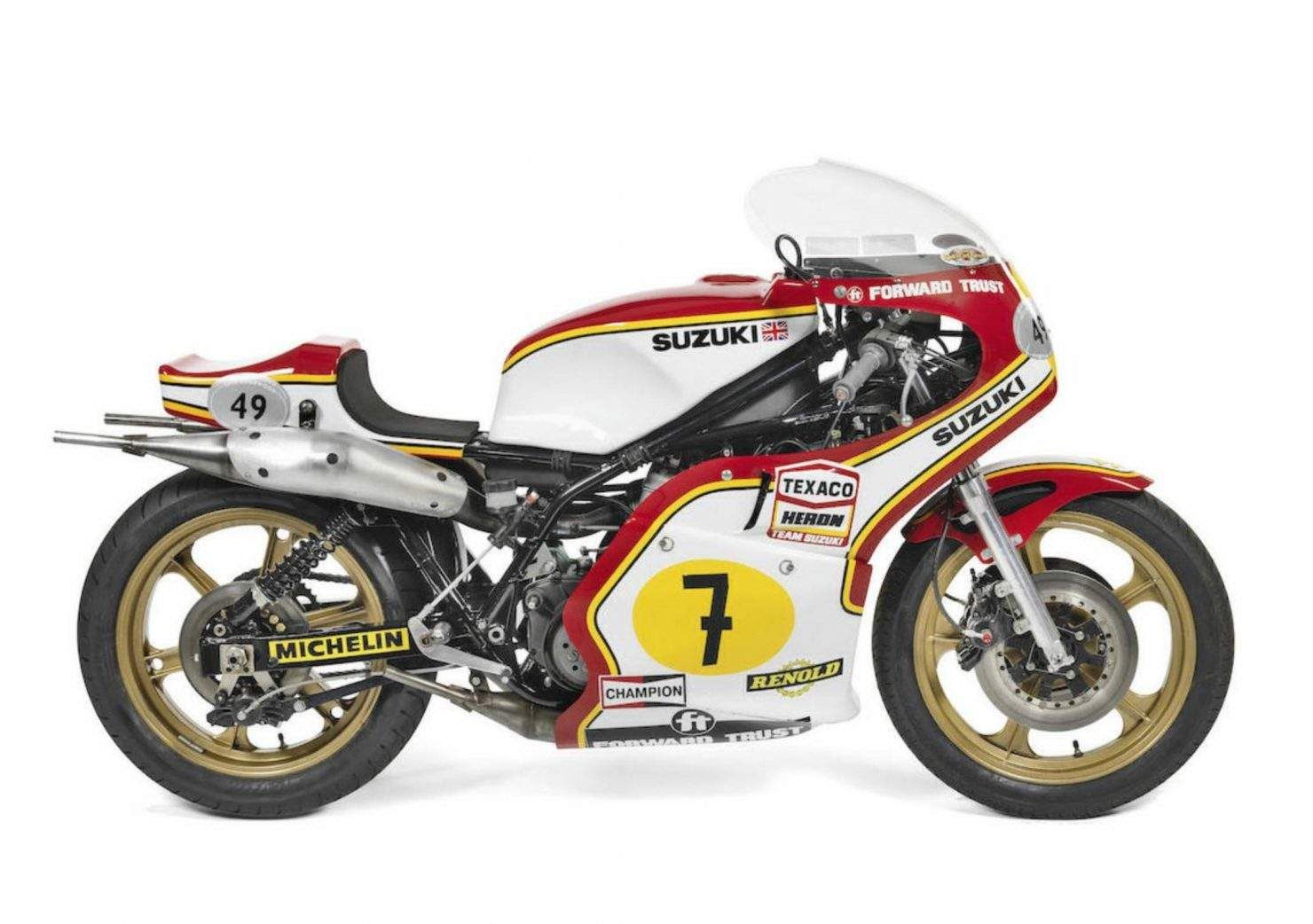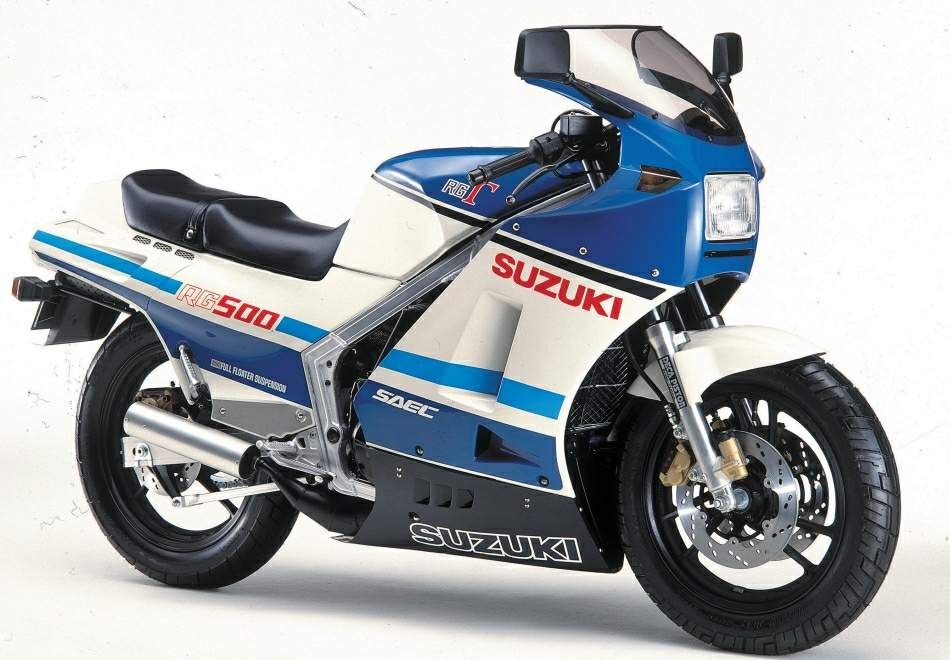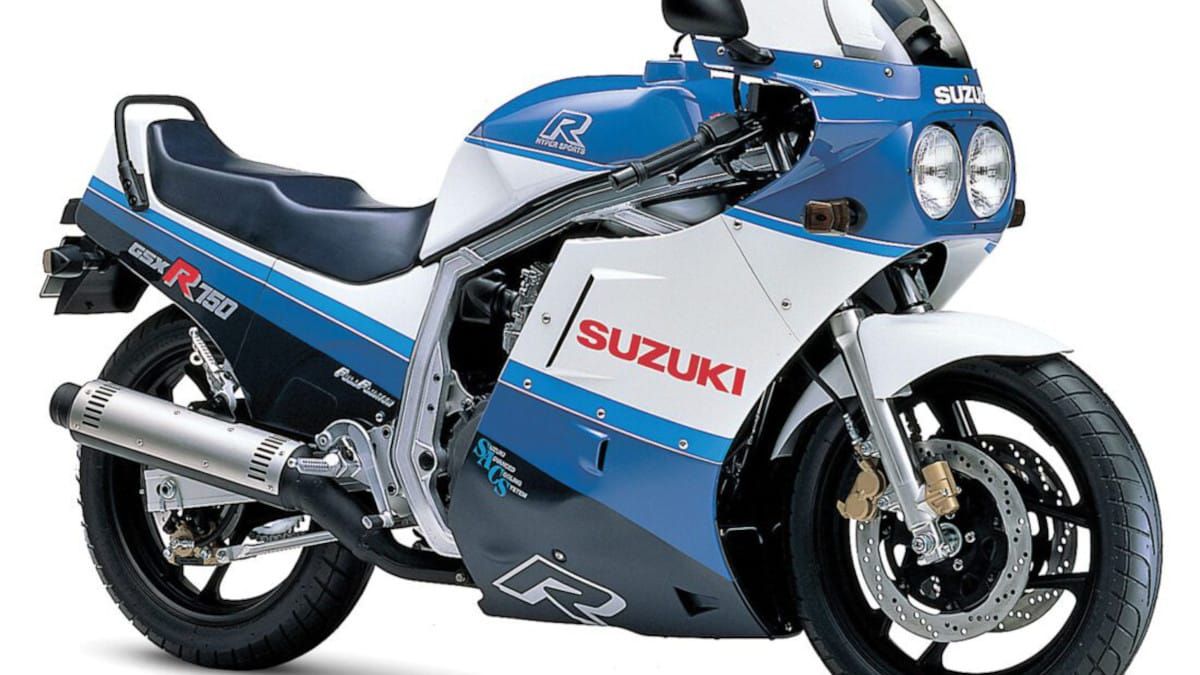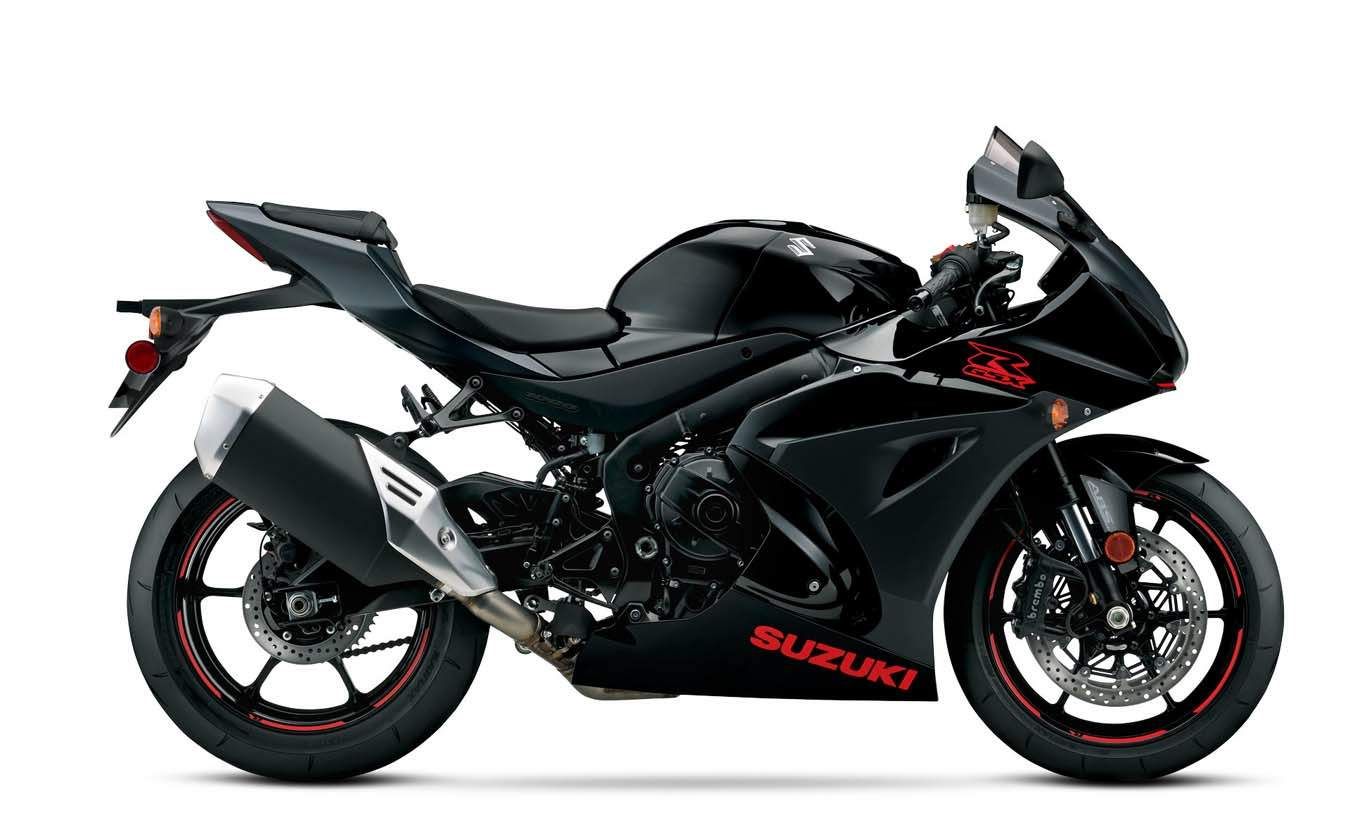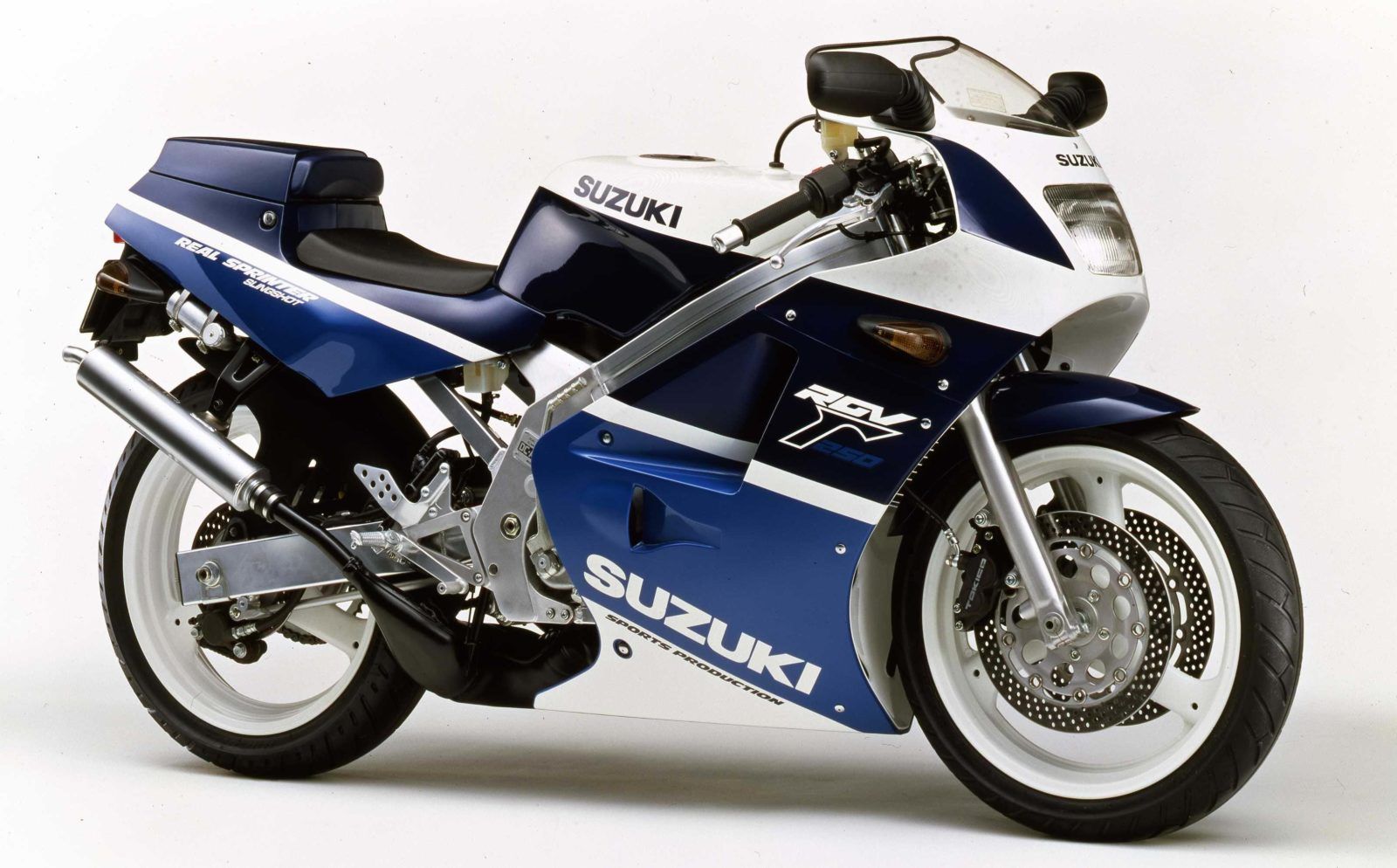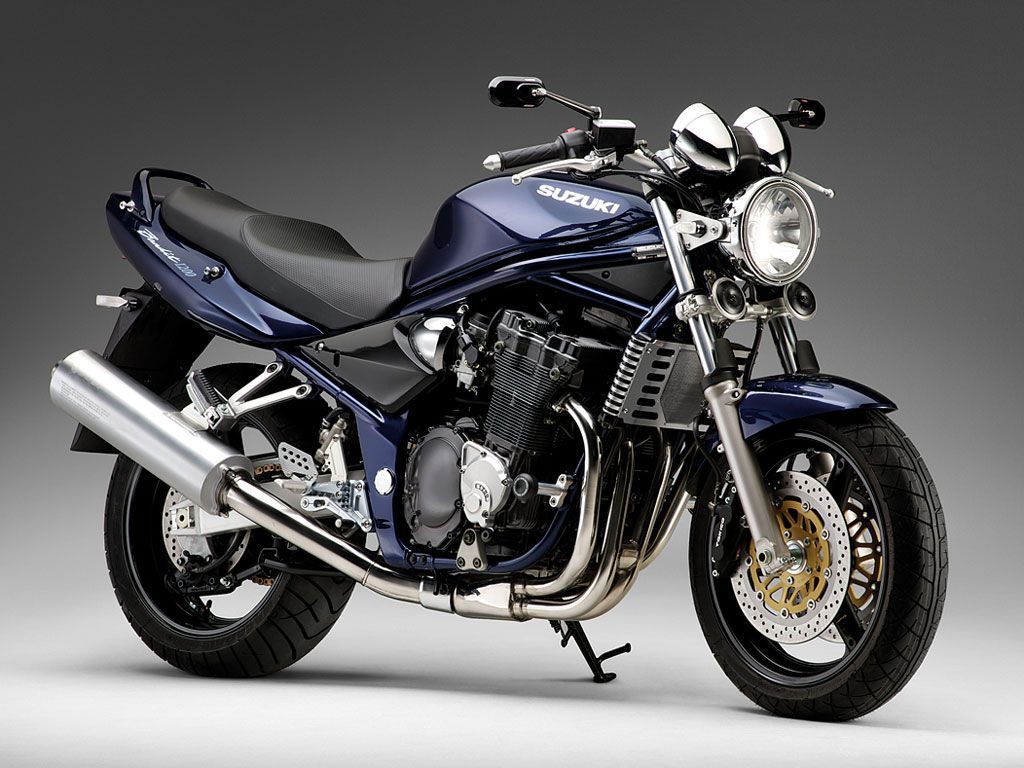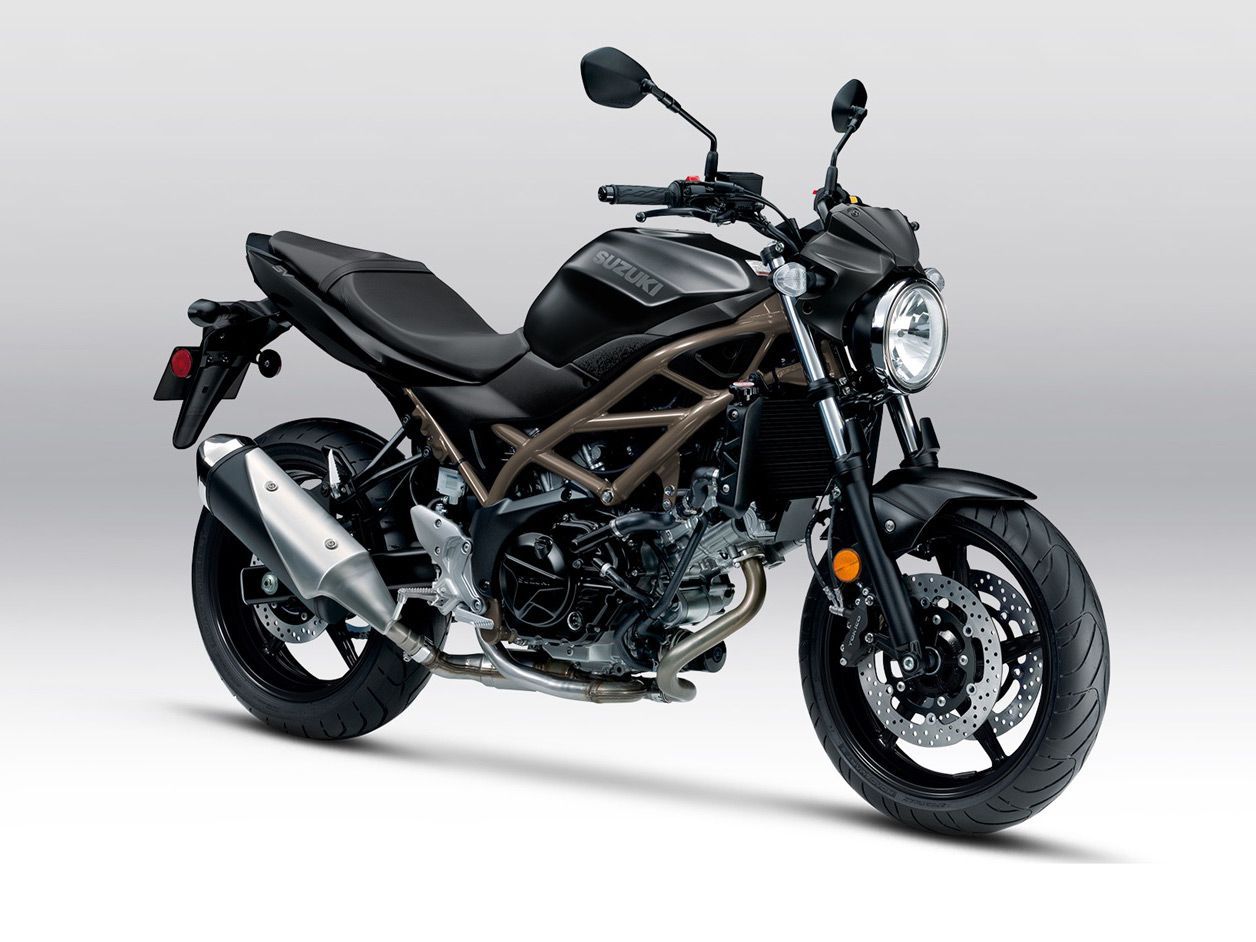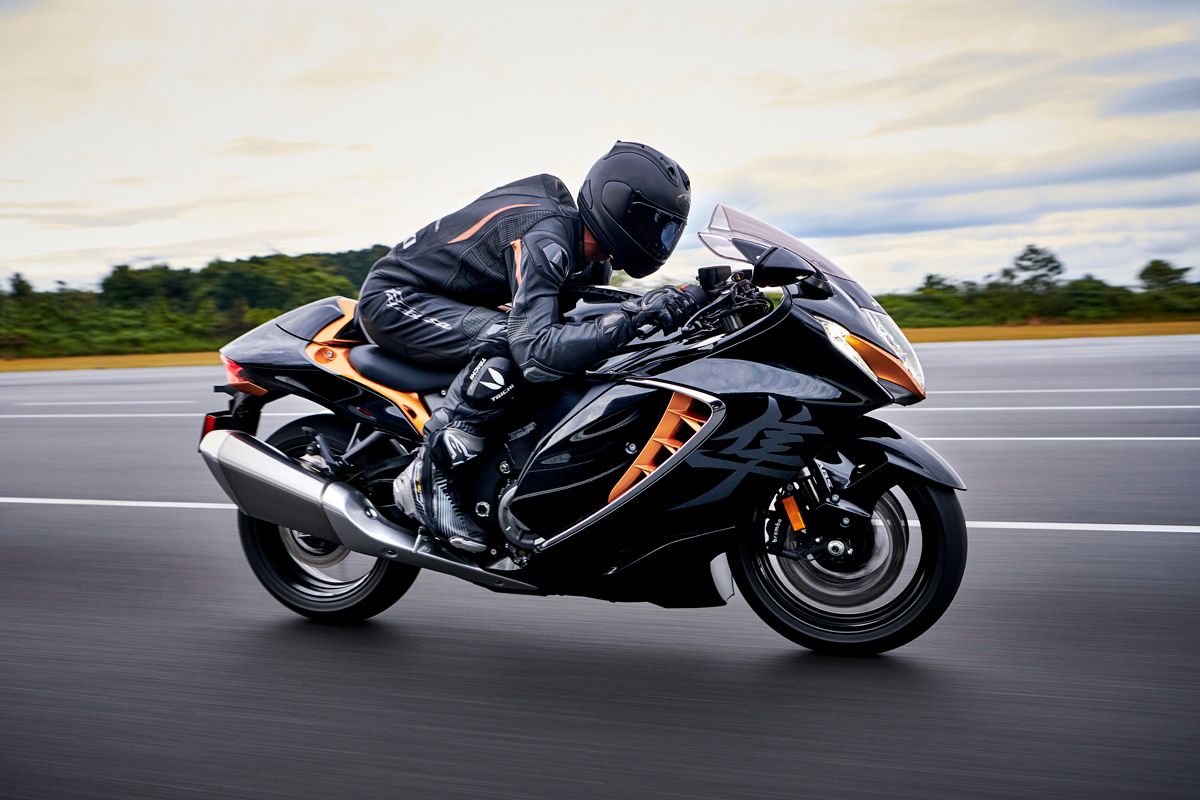If you were to ask a casual bystander to name a Japanese motorcycle manufacturer, the chances are that Suzuki would be the last out of the big four to be mentioned. Why is that? Like Honda, Kawasaki, and Yamaha, Suzuki started building motorcycles in the aftermath of the second world war, when cheap, efficient transport was needed by the entire population, so it’s not like the others stole a march. Like Kawasaki and Yamaha, the Suzuki empire was founded on an industry completely opposite to wheeled transport: in Suzuki’s case, weaving looms at the beginning of the 20th century. And yet, Suzuki has the lowest profile of the big four. Suzuki might be the smallest in terms of manufacturing numbers, but that doesn’t mean it hasn’t had its fair share of influence over the motorcycle market so we thought it was about time to redress the balance and bring Suzuki into the spotlight with our list of the top ten Suzukis in its history.
10 Suzuki Power Free
How can we not start with the ‘motorcycle’ that started it all? After the Second World War had finished, Japan was in dire need of cheap transport solutions and Japanese industry was needing products to manufacture to stay in business: the two needs came together perfectly. As with the dawn of the motorcycle in Europe, the first Japanese motorcycles were basically bicycles with small proprietary engines bolted onto them, often driving the front wheel. The Suzuki Power free was no different, although it is significant in that it was the first Suzuki to use an engine of Suzuki’s own design and manufacture. This was a single-cylinder two-stroke engine of 36cc, developing one horsepower, driving through a two-speed gearbox to the rear wheel. Launched in 1953, the engine was soon enlarged to 60cc and, by 1954, 6,000 bikes a month were being built. From small acorns…
9 Suzuki RM-62
In line with its Japanese rivals, Suzuki saw racing as a necessary evil to both promote the brand and to push development and so, by the early 1960s, it was active in European road racing. However, Suzuki was not above a bit of skulduggery, if it meant they could win. Ernst Degner was an East German rider, riding for MZ. The chief engineer at MZ, Walter Kaaden, had perfected expansion chamber exhaust systems for two-stroke engines and Degner was all-but unbeatable in the 1957 East German 125cc road racing championship. In 1961, however, Degner, tired of the oppressive communist regime, defected to Western Europe and was quickly snapped up by Suzuki, as much for his knowledge of Kaaden’s work and techniques as for his riding ability. It worked! Suzuki designed a 50cc, two-stroke engine that produced 10 horsepower, revved to 12,000rpm and could achieve 90mph. The resulting RM-62 dominated 50cc Grand Prix racing in the 1960s, winning six world championships and putting Suzuki firmly on the map.
8 Suzuki RG 500
While Suzuki was making hay in the 50cc Grand Prix class in the 1960s, rival Honda was competing and winning in the 125cc, 250cc, 350cc, and 500cc class, winning multiple titles although, ironically, not the Blue Riband 500cc title, despite the efforts of Mike Hailwood and Jim Redman, both multiple world champions themselves. Into the 1970s, however, two-stroke technology came to the fore in GP racing, and by 1975, the first 500cc world championship had been taken by a two-stroke engine - Agostini on a Yamaha. This was Suzuki’s time to shine, with all its expertise in two-stroke racing engines and the RG 500 was the result. The engine was a square four two-stroke engine, initially producing 90 horsepower at 11,000rpm, and it would dominate 500cc GP racing for the next seven years, taking seven manufacturers’ titles in succession between 1974 and 1980 and winning the riders’ title for Barry Sheene in 1976 and ’77 and again in 1981 and ’82 with Marco Lucchinelli and Franco Uncini respectively. It remained a potent force in GP racing long into the 1980s and gave many a privateer a start in racing, the factory eagerly selling the RG to non-factory riders.
7 Suzuki RG500 Gamma
Okay, if we’ve got the RG 500 on this list, then we have to have the RG500 Gamma, possibly the last GP-derived bike the public was able to buy for use on the road. The Gamma was so close to the Grand Prix bike it was unreal: twin crank, square four, two-stroke engine with disc valves and flat-slide carburetors housed in a light aluminum frame. 95 horsepower with a wet weight of 386 pounds spelled ridiculous performance, even if there was absolutely no power below 5,000rpm and it all came in with a bang above that. Absolute lunacy for the roads: we need that in our lives again!
6 Suzuki GSX-R750
Arguably the first ‘proper’ race replica motorcycle, the GSX-R750 of 1985 re-wrote the road-going sports bike rule book in one fell swoop. The oil-cooled 749cc inline-four had dual overhead camshafts and pushed out 100 horsepower which was a lot of power in the mid-1980s. The GSX-R750’s trump card, however, was both its lightweight and cradle-type frame made from square-section aluminum tubes which were super stiff, allowing the track-derived suspension to do its work effectively. The GSX-R750 was the genesis of the race-bike-influenced sports bikes that would dominate the market from the 1990s onwards and was still in production up to 2018, by which time the engine was producing 150 horsepower while having only put on 16kgs of weight. A true classic.
5 Suzuki GSX-R1000
In 1994, Honda redefined the sports bike with the CBR900RR Fireblade, which took the GSX-R750s ideas of excellent power-to-weight ratio to a new level. Initially, Suzuki responded with a sledgehammer in the form of the GSX-R1100, but it was nowhere near as light or nimble as the Fireblade so, in 2001, Suzuki revealed the first GSX-R1000, the internally designated K1. The engine was a long-stroke version of the 750 and pushed out 160 horsepower, with the whole bike weighing in at only 374 pounds, slightly better than the class-leading Yamaha R1. Continually evolving over the years, the 2005 K5 variant was a particular high point, with 178 horsepower from a completely redesigned engine. The latest GSX-R1000 has variable valve timing and 200 horsepower and remains as sharp and thrilling today as it was 21 years ago.
4 Suzuki RGV250
Proof that bigger isn’t necessarily better. The utterly fantastic RGV250 was built between 1988 and 1998 and incorporated technology and design cues from Suzuki’s 250cc Grand Prix race bikes of the same period. The RGV250 continued the previous RG250 Gamma’s ground-breaking use of an all-aluminum frame and put into it a 249cc, 60 horsepower, V-Twin two-stroke engine. The whole bike weighed 282 pounds at the beginning, rising to 309 pounds for later models. The top speed was a frankly unbelievable 130mph and acceleration, if you kept the engine within its narrow 2,000rpm powerband, was shattering. It was pure, unadulterated performance, and in the right hands, an RGV250 could murder 1000cc sports bikes on the track. The end for bikes such as the RGV250 was the proliferation of imported 400cc, four-stroke bikes which were much more reliable and easier to maintain. While they lasted, however, 250cc two-stroke screamers were some of the best sports bikes money could buy.
3 Suzuki Bandit 1200
It might have been a parts-bin special, using components from many other Suzuki models, but that doesn’t stop the Bandit 1200 from being an important bike in Suzuki’s history, largely because it cost so little to develop and sold so well, making Suzuki a lot of money. The engine was a re-tuned GSX-R1100 unit, with more mid-range torque and around 97 horsepower overall, which is fantastically under-stressed for an engine of this size and helped cement Suzuki’s reputation for bulletproof engineering. If the rest of the bike was conventional, with a steel tube frame, aluminum box-section swing arm, and relatively low-spec suspension and brakes, then it all added to the innate usability of the bike, something that a lot of customers appreciated. For all its lack of sophisticated componentry, the Bandit was a joy to ride, with safe, predictable handling and excellent, smooth performance from the engine. Best of all, because the engine was so unstressed, it was tuneable to a huge degree without having to change the basic structure or internals.
2 Suzuki SV650
Suzuki has played big in the 600cc class over the years, with no fewer than four separate 600cc platforms in the early 2000s: the Bandit roadsters, the GSX-R600 sports bike, the Burgman 650 maxi-scooter and the SV650. The SV650 was unique among competitors in having a punchy liquid-cooled V-Twin engine producing around 70 horsepower and plenty of grunty torque. Solid, relatively sporty, perhaps a little understated and dowdy but, like so many Suzukis, it proved itself to be absolutely bulletproof mechanically and, actually, great fun to ride, with a decent chassis and with basic suspension and braking components proving to be a lot better in practice than on paper. It’s compact, light, and has a good riding position: it’s comfortable, cheap to run and repair, and it will last forever. It’s both the perfect beginners’ bike and great for any rider who knows what they’re doing. Being replaced with a parallel-twin-engined model for 2023.
1 Suzuki GSX1300R Hayabusa
The legend! The GSX1300R Hayabusa made its name not only for being fast but for the way it looked. Polarizing is one way to describe the swoopy bodywork, designed with only one thing in mind: stability at high speed, which is what the Hayabusa was built for. In the 1990s, there was a surge in unlimited supersports-tourer bikes coming from Japan: Kawasaki’s ZZR-1100 and Honda’s Super Blackbird, for example. When Suzuki had a go, it had to beat everyone, especially the Blackbird (Hayabusa is Japanese for the peregrine falcon, the fastest bird in nature and one that preys on blackbirds!) And, it did so with a 174 horsepower engine in a lengthened sports bike chassis clothed in that bodywork. It wasn’t only fast, but comfortable too, making it perfect for long-distance tours. However, the Japanese were getting worried that this boom in performance was going to rile the legislators in Europe and, fearing a clampdown on motorcycles they had spent millions developing, agreed to a voluntary top speed limit of 300km/h (186mph). Like that was going to make any difference! The ‘Busa, as it is affectionately known, is still with us in 2022, in its third generation, just as fast as ever but with new bodywork that has tamed down the looks, but never the speed.
FAQ
Q: Are Suzuki bikes better than Honda?
No, not necessarily. But Suzuki might make a bike that fits your purpose better than any of the Honda models.
Q: Is Suzuki motorcycle a good brand?
Yes, Suzuki has a great reputation for building well-engineered, fast, and desirable motorcycles
Q: Is Kawasaki made by Suzuki?
No, Kawasaki has nothing to do with Suzuki, and vice versa: they are both entirely separate companies.

